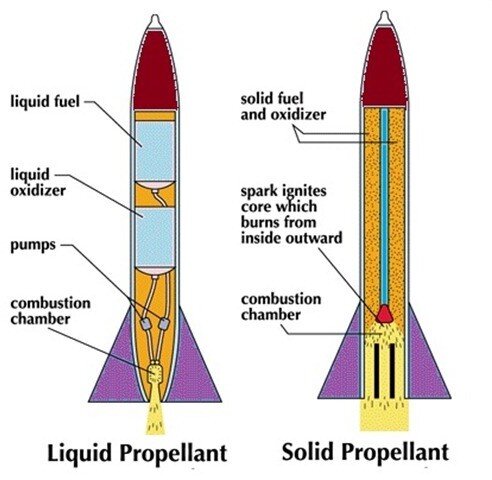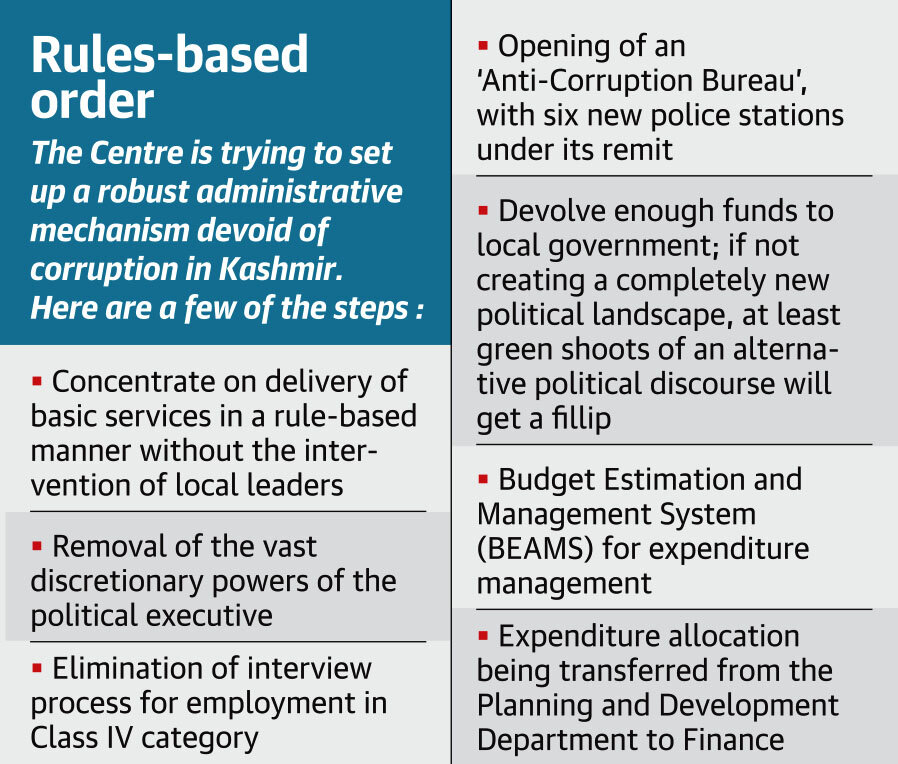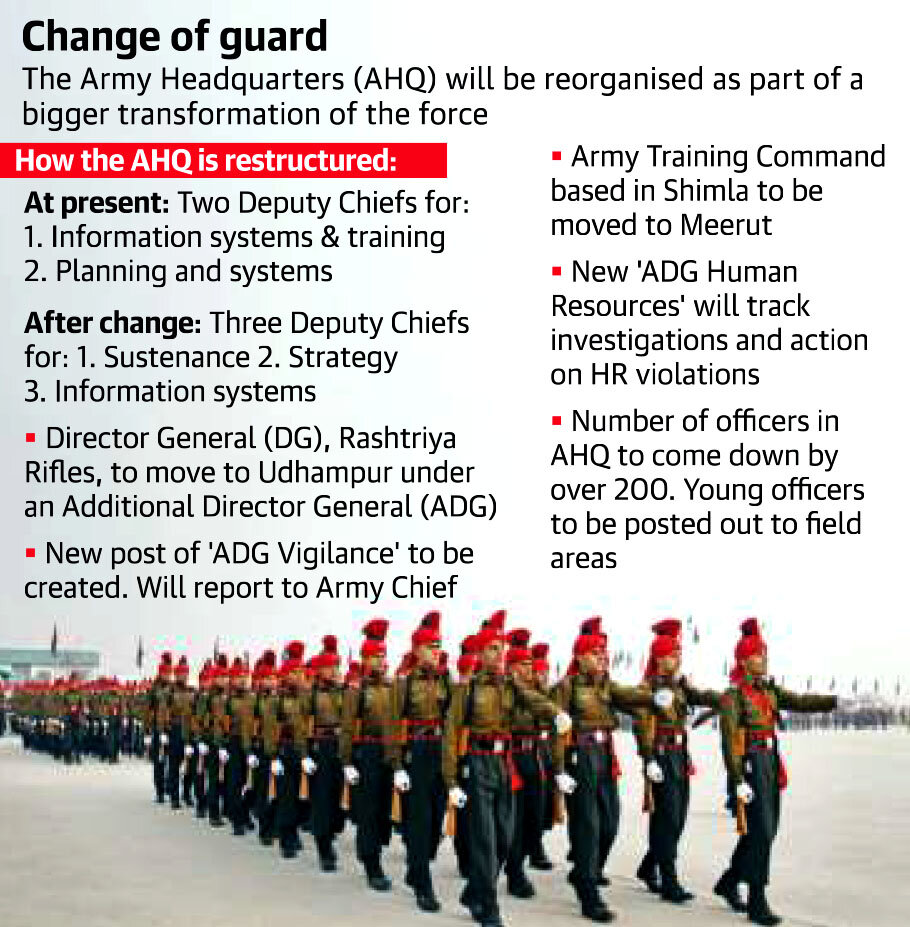Governance
Governance Reforms in Jammu and Kashmir
The Parliament has extended the President Rule In Jammu & Kashmir for another six months.
Governance Issues in J&K
The Central government has extended its rule in the state while promoting grassroot democracy which seems contradictory and violation of spirit of federalism. Other issues involved are:
- Poor economic development.
- Failure to deliver even basic facilities.
- Widespread corruption among government employees.
- Human Rights Abuse.
- Unemployment among youth.
- Security threat from Cross border infiltration.
Initiatives Taken to address governance issues in J&K
- Divisional Status to Ladakh
- ‘Back to Villages’ program under which government officers visit villages to redress grievances of people at their doorsteps.
President's Rule in J&K
- In case of breakdown of Constitutional machinery in the state, there are two prescriptions
- Governor's Rule under J&K Constitution
- Presidential Rule under the Indian Constitution (Article 356)
- Governor's rule is first imposed for six months in the state with the approval of the President. In case, the constitutional crisis is not resolved within 6-months, President's Rule is extended to the state under article 356 of Indian Constitution for a maximum period of 3-years with Parliamentary approval after every 6 months.
- President's Rule is extended to other states in case of breakdown of constitutional machinery under Art. 356 and under Art. 365 in case of failure of state govt to comply with orders of Central Govt. However, there is no such provision of Governor's Rule in other states.
Science & Technology
Rocket Fuel
The fuel that will power the core (or the middle unit of the lower part) of the GSLV Mk-III, the rocket to be used in the Chandrayaan-2 mission is UDMH (Unsymmetrical Di-Methyl Hydrazine).
- The Indian Space Research Organisation(ISRO) is using the highly toxic and corrosive fuel UDMH (Unsymmetrical Di-Methyl Hydrazine), along with the oxidiser nitrogen Tetroxide. This is called a “dirty combination”.
- Elsewhere in the world, space programmes have moved to a cleaner and greener fuel — liquid methane or kerosene.
- Shifting to liquid methane would mean bringing in cryogenic engine because any gas would need to be kept in extremely low temperatures to stay liquefied.
- GSLV Mk III is a three-stage heavy-lift launch vehicle developed by ISRO. The vehicle has two solid strap-ons, a core liquid booster and a cryogenic upper stage.
- GSLV Mk III is designed to carry 4 ton class of satellites into Geosynchronous Transfer Orbit (GTO) or about 10 tons to Low Earth Orbit (LEO), which is about twice the capability of GSLV Mk II.
Propellant Used in Rocket
- The propellant is the chemical mixture burned to produce thrust in rockets and consists of a fuel and an oxidizer.
- Fuel is a substance that burns when combined with oxidiser for propulsion.
- The oxidizer is an agent that releases oxygen for combination with a fuel. The ratio of oxidizer to fuel is called the mixture ratio.
- Propellants are classified according to their state - liquid, solid, or hybrid.
- Liquid Propellants: In a liquid propellant rocket, the fuel and oxidizer are stored in separate tanks and are fed through a system of pipes, valves, and turbopumps to a combustion chamber where they are combined and burned to produce thrust.
- Advantages: Liquid propellant engines are more complex than their solid propellant counterparts, however, they offer several advantages. By controlling the flow of propellant to the combustion chamber, the engine can be throttled, stopped, or restarted.
- Disadvantages: The main difficulties with liquid propellants are with oxidizers. Storable oxidizers, such as nitric acid and nitrogen tetroxide are extremely toxic and highly reactive, while cryogenic propellants being stored at low temperature and can also have reactivity/toxicity issues.
- Liquid propellants used in rocketry can be classified into three types: petroleum, cryogens, and hypergolic.
- Petroleum fuels are those refined from crude oil and are a mixture of complex hydrocarbons, i.e. organic compounds containing only carbon and hydrogen. The petroleum used as rocket fuel is a type of highly refined kerosene.
- Cryogenic propellants are liquefied gases stored at very low temperatures, most frequently liquid hydrogen (LH2) as the fuel and liquid oxygen (LO2 or LOX) as the oxidizer. Hydrogen remains liquid at temperatures of -253 oC (-423 oF) and oxygen remains in a liquid state at temperatures of -183 oC (-297 oF).
- Hypergolic propellants and oxidizers that ignite spontaneously on contact with each other and require no ignition source. The easy start and restart capability of hypergolic make them ideal for spacecraft manoeuvring systems.
- Since hypergolic remain liquid at normal temperatures, they do not pose the storage problems like cryogenic propellants. Hypergolic are highly toxic and must be handled with extreme care. Hypergolic fuels commonly include hydrazine, monomethyl-hydrazine (MMH) and unsymmetrical dimethyl-hydrazine (UDMH).
- Solid propellant: These are the simplest of all rocket designs. They consist of a casing, usually steel, filled with a mixture of solid compounds (fuel and oxidizer) that burn at a rapid rate, expelling hot gases from a nozzle to produce thrust. When ignited, a solid propellant burns from the centre out towards the sides of the casing.
- There are two families of solids propellants: homogeneous and composite. Both types are dense, stable at ordinary temperatures, and easily storable.
- Composites are composed mostly of a mixture of granules of solid oxidizers, such as ammonium nitrate, ammonium dinitramide, ammonium perchlorate, or potassium nitrate in a polymer binding agent.
- Single-, double-, or triple-bases (depending on the number of primary ingredients) are homogeneous mixtures of one to three primary ingredients.
- Advantages: Solid propellant rockets are much easier to store and handle than liquid propellant rockets. High propellant density makes for compact size as well.
- Disadvantages: Unlike liquid-propellant engines, solid propellant motors cannot be shut down. Once ignited, they will burn until all the propellant is exhausted.
- Hybrid propellant: These engines represent an intermediate group between solid and liquid propellant engines. One of the substances is solid, usually the fuel, while the other, usually the oxidizer, is liquid. The liquid is injected into the solid, whose fuel reservoir also serves as the combustion chamber.
- The main advantage of such engines is that they have high performance, similar to that of solid propellants, but the combustion can be moderated, stopped, or even restarted. It is difficult to make use of this concept for very large thrusts, and thus, hybrid propellant engines are rarely built.
Cryogenic Rocket
- A cryogenic rocket engine is a rocket engine that uses a cryogenic fuel or oxidizer, that is, its fuel or oxidizer (or both) are gases liquefied and stored at very low temperature.
- A Cryogenic rocket stage is more efficient and provides more thrust for every kilogram of propellant it burns compared to solid and earth-storable liquid propellant rocket stages. Specific impulse achievable with cryogenic propellants (liquid Hydrogen and liquid Oxygen) is much higher compared to earth storable liquid and solid propellants, giving it a substantial payload advantage.
- Oxygen liquefies at -183 deg C and Hydrogen at -253 deg C also entails complex ground support systems like propellant storage and filling systems, cryo engine and stage test facilities, transportation and handling of cryo fluids and related safety aspects.
Specific Impulse
- The gauge for rating the efficiency of rocket propellants is specific impulse, stated in seconds. Specific impulse indicates how many pounds (or kilograms) of thrust are obtained by the consumption of one pound (or kilogram) of propellant in one second.
- Specific impulse is characteristic of the type of propellant, however, its exact value will vary to some extent with the operating conditions and design of the rocket engine.
Indian Polity
Electronically Transmitted Postal Ballot System
The Election Commission of India’s Electronically Transmitted Postal Ballot System has recorded a highest service voter turnout ratio during Lok sabha election 2019.
- ETPBS enables the entitled service voters to cast their vote (on electronically received postal ballot) from their preferred location, which is outside their originally assigned voting constituency.
- Service voters: Individuals working in central forces under arms act and government officials deployed in embassies outside the country are classified as service voters and are provisioned for online enrolment.
- It is developed by the Election Commission of India with the help of Centre for Development of Advanced Computing (C-DAC), for the use of the service voters.
Eligibility
- Classified service voters, other than those who opt for proxy voting.
- The wife of a service voter who ordinarily resides with him.
- Overseas voters
Features
- Flexibility: Service voters can avail this service from anywhere outside their assigned constituency.
- Database: System facilitates creation of service voter electoral roll data.
- Secure: It is a secure system, having two layer of security:
- OTP (one time password) is required to download encrypted electronically transmitted postal ballot file.
- PIN is required to decrypt, print and deliver ETPB.
- Less time consuming: Time constraint involved in dispatch of postal ballot has been addressed using this system, as it sends postal ballots electronically to eligible service voters.
- No duplication: Secrecy is maintained and no duplication of casted ETPB is possible due to the unique quick response code.
Internal Security
Bhabha Kavach
India’s lightest and cheapest bullet proof jacket ‘Bhabha Kavach’ was displayed at the International Police Expo 2019 held at Pragati Maidan in New Delhi.
- The expo was organised by Nexgen Exhibitions (Asia’s leading and established trade fair, exhibition and conference organizer).
- The bullet proof jacket weighs just 6.6 kg (in comparison to traditional jackets which weigh around 17-kg).
Production and Development
- Bhabha Kavach was developed indigenously by Defence organizations like Ordnance Factory Board and Mishra Dhatu Nigam Limited (MIDHANI) with transfer of carbon-nanomaterial technology from Bhabha Atomic Research Centre (BARC).
- MIDHANI, is a (public sector undertaking) specialized metals and metal alloys manufacturing facility in India, located in Hyderabad, Telangana.
- Ordnance Factory Board is an industrial organisation, functioning under the Department of Defence Production , Ministry of Defence (headquartered in Kolkata).
Manufacturing
- Bhabha Kavach is built from layers of high-density, high-tenacity polyethylene, which are fused together at high temperatures to form a thick, hard armour plate, which is then sprayed with BARC’s carbon nanomaterial.
- The material used in the jacket are hard boron carbide ceramics, carbon nano-tubes and composite polymer (polymer made up of two or other types of polymer).
Bhabha Atomic Research Centre
- BARC is India’s premier nuclear research facility based in Mumbai, Maharashtra.
- It is a multi-disciplinary research center with extensive infrastructure for advanced research and development.
- Its core mandate is to sustain peaceful applications of nuclear energy, primarily for power generation.
Need
- In the backdrop of several terrorist attacks ( like Uri , Pulwama), Indian security forces are in the dire need to develop an advanced, efficient and cost-effective security system which can potentially deal with the fast changing threats of the 21st century.
- Central Armed Police Forces like Central Reserve Police Force, Border Security Force, Indo-Tibet Border Police, and Sashastra Seema Bal, which secure our border areas are more exposed to security threats and hence, Bhabha Kavach has been designed to protect Indian defence forces against:
- AK-47 rifle: 7.62mm hard steel core or bullets fired from an AK-47 rifle.
- INSAS bullet: 5.56mm Indian Small Arms System (INSAS) bullet.
- SLR: 7.65mm bullet of self-loading rifle (SLR).
Governance
Reforms in Army
Government has approved major reforms in the Indian Army which will begin with the restructuring of Army Headquarters.
- The Army headquarters had instituted 4 studies with an overall aim to enhance the operational and functional efficiency of the force, optimize budget expenditure, facilitate modernization and address aspirations.
- ‘Re-organisation and right-sizing of the Indian Army’ which focuses on operational structures to make the force efficient and future-ready by taking into account the operational situation on western and northern borders.
- ‘Re-organisation of the Army Headquarters’ with an aim to bring in "integration and preclude the redundancies.
- ‘Cadre review of officers' whose focus was to recommend how to carry out reorganization and restructuring to meet the aspirations of the officers' cadre.
- 'Review of terms of engagement of rank and file' which was aimed at harnessing the higher life expectancy and ensuring the younger profile of key commands and motivation of the personnel.
Shekatkar Committee
- Ministry of Defence under the chairmanship of Lt. Gen (Retd) DB Shekatkar had constituted a committee to recommend measures to enhance combat capability and rebalance defence expenditure of the armed forces in 2015.
- Recommendations:
- Closure of Military Farms and Army Postal Establishments in peace locations.
- Enhancement in standards for recruitment of clerical staff and drivers in the Army.
- Improving the efficiency of the National Cadet Corps.
- Recommended a roll-on defence budget to have enough capital expenditure available for modernisation as against the present practice of surrendering unspent capital budget at the end of each financial year.
Important Facts For Prelims
Colistin Antibiotic
The Ministry of Health and Family Welfare has issued an order prohibiting the manufacture, sale and distribution of Colistin and its formulations for food-producing animals, poultry, aqua farming and animal feed supplements.
- The ban has been imposed under the provisions of the Drugs and Cosmetics Act, 1940.
- The Drug Technical Advisory Board (DTAB), the government’s top advisory body on technical matters related to drugs in the country recommended prohibiting it.
- Colistin is an antibiotic for therapeutic purpose in veterinary. But the drug is highly misused in poultry industry as a growth promoter for prophylactic purpose.
- Also, colistin is a valuable, last-resort antibiotic that saves lives in critical care units but in recent years, there have been patients who have exhibited resistance to the drug.
- This move is likely to reduce the antimicrobial resistance within the country.
- Awareness programmes need to be conducted for farmers telling them about the dangers of using colistin in feed.
- Since the bulk of Colistin (nearly 95%) is imported from China, it would be easy to stop importing it within a short time.
- China, one of the largest manufacturers of colistin, has banned the use of the same within its boundaries for any producing animals or fish reared for consumption.
Important Facts For Prelims
Ratapani Wildlife Sanctuary
The Madhya Pradesh government has decided to declare the Ratapani Wildlife Sanctuary a tiger reserve. The state received an approval for the same from the National Tiger Conservation Authority (NTCA) 11 years ago.
- The sanctuary is spread over 890 sqkm in Bhopal-Raisen forest division of Madhya Pradesh.
- The sanctuary has a population of about 40 tigers and the movement of 12 tigers has been reported in the forest area of Bhopal. The whole area will be combined as one to declare it as a tiger reserve.
- The area of about 3,500 sq km of Raisen, Sehore and Bhopal districts has been reserved for the same. The 1,500 sq km will be designated as a core area while 2,000 sq km as a buffer zone.
- The declaration of the sanctuary as a tiger reserve will help in better conservation of tigers in the area which is facing the problem of illegal mining and poaching.
Important Facts For Prelims
Producing New Antibiotics Through Robotics
Researchers have produced a new class of antibiotics, known as class II Polyketides, by using robotics to engineer Escherichia coli (E. coli), a common gut bacterium.
- These antibiotics are also naturally produced by soil bacteria and have antimicrobial properties which are vital in the modern pharmaceutical industry to combat infectious diseases and cancer.
- The naturally produced Escherichia coli bacteria are difficult to work with as they grow in dense clumps that are incompatible with the automated robotic systems used for modern biotechnology research.
- By transferring the production machinery from the soil bacteria into E. coli, the researchers have made this class of antibiotics accessible for much more rapid exploration.
- This breakthrough could be vital for the ongoing combat against antimicrobial resistance, as recently developed automated robotics systems can now be used to create new antibiotics in a fast and efficient way.
- It will now be possible to explore and engineer polyketides using robotic systems to develop new and diversified polyketides in an automated, rapid and versatile fashion.
Antibiotics
- Antibiotics are chemical substances, which are produced by some microbes and can kill or retard the growth of other (disease-causing) microbes.
- Penicillin was the first antibiotic to be discovered. This antibiotic was extensively used to treat American soldiers wounded in World War II.
Important Facts For Prelims
Social Engineering Attacks
Recently, The Ministry of Home Affairs (MHA) issued warning to government officials against 'social engineering' attacks
- The MHA asked officials to avoid unsolicited phone calls, visits or email messages from unknown persons claiming to represent some organisation, to prevent the leak of sensitive information.
What is Social Engineering Attack?
- Social engineering attack involves manipulating people into breaking normal security procedures and best practices in order to gain access to systems, networks or physical locations, or for financial gain. It relies heavily on human interaction.
- Social engineering attack manipulates government officials to obtain sensitive information without letting them realise that a security breach is occurring.
- The MHA held that hackers often ask for information by sending an email or text message.
- Phishing: The email or text message carrying a link appears to come from a trusted source like a bank.
- The link takes you to a fake website and once details like login name and passwords are entered, the login credentials reach to the hacker.
- Quid pro quo attack: In this case, a hacker comes posing as a technician and uploads malware with the intention to steal information from the system.






